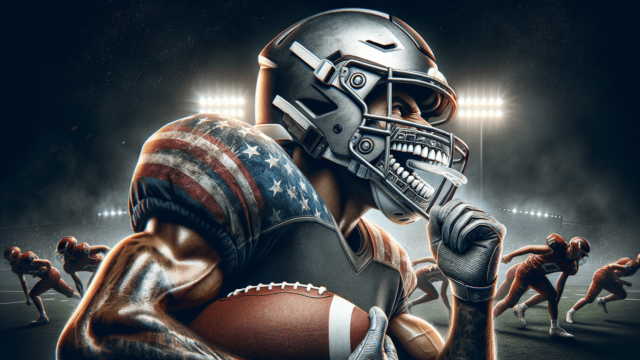
A football helmet typically weighs between 4 to 6 pounds (1.8 to 2.7 kilograms), with variations based on size, materials, and design.
Understanding Football Helmet Weight
A football helmet’s weight is an important aspect that influences player comfort, safety, and performance. The typical football helmet’s weight ranges from 4 to 6 pounds (1.8 to 2.7 kilograms), coming from various components like the shell, face mask, padding, and chin strap.
Factors Affecting Football Helmet Weight
Different elements contribute to the overall weight of a football helmet, including:
1. Helmet Size
Larger helmets designed for players with bigger head sizes will inevitably weigh more due to the increased material needed for construction.
2. Materials
Helmets made of lighter materials like composite constructions or carbon fiber can reduce overall weight without compromising safety.
3. Face Mask Design
The design and material of the face mask can also affect helmet weight. Some masks are made with heavier metals, while others use lighter alloys or polymer materials.
4. Padding
The type, density, and thickness of the padding used in a helmet will contribute to its weight. Lightweight padding materials are being developed to maintain safety while minimizing weight.
5. Additional Features
Unique safety features, like shock-absorbing or impact-reducing components, might add extra weight to a football helmet.
Importance of Helmet Weight for Players
While the focus on helmet weight is primarily for safety and performance reasons, user comfort is also of considerable importance:
1. Neck Strain
A lighter helmet can help reduce neck strain, enhancing player comfort during long matches and training sessions.
2. Range of Motion
Helmets with a lower weight can provide players with a greater range of motion and freedom of movement, ultimately improving performance.
3. Reducing Fatigue
Heavier helmets can contribute to player fatigue; thus, opting for a lighter helmet can help players maintain their energy levels throughout the game.
Finding the Right Football Helmet
Selecting the appropriate football helmet is crucial for a player’s safety and overall experience. To find the right helmet:
1. Accurate Head Measurement
Measure the circumference of the player’s head using a flexible tape measure or string and choose the corresponding helmet size accordingly.
2. Proper Fit
A helmet should fit snugly on the player’s head; it should not move around during play or be so tight that it causes discomfort.
3. Retention System
Ensure the helmet’s chin strap and buckle system provides a secure and firm hold, reducing the risk of the helmet coming off during impact.
Helmet Safety Standards
Football helmets must adhere to safety standards set by governing bodies like the National Operating Committee on Standards for Athletic Equipment (NOCSAE). These standards are continually updated as new technologies and methods are developed to enhance the safety of helmets.
1. NOCSAE Approval
Verify that the helmet has been certified by NOCSAE, ensuring it adheres to stringent safety regulations.
2. Reconditioning and Recertification
Helmets should be periodically inspected, reconditioned, and recertified to keep them in optimal condition and meet safety requirements. Consult with manufacturers, school officials, or a certified reconditioning agent for more information.
Maintaining a Football Helmet
Proper care and maintenance of a football helmet help ensure its safety, effectiveness, and longevity:
1. Inspection
Before and after each use, inspect the helmet for cracks, loose hardware, or other signs of damage that might compromise the helmet’s safety.
2. Cleaning
Regularly clean your helmet using mild soap, warm water, and a soft cloth to remove dirt and sweat. Do not use abrasive cleaners or solvents, as these can damage the materials.
3. Storage
Store the helmet in a cool, dry place, avoiding excessive heat or humidity that could harm the helmet’s structure and materials.
FAQ Section
Below are some frequently asked questions and answers related to football helmet weight. These questions focus on aspects that are important to players, coaches, and equipment managers when making decisions about football helmets.
How often should football helmets be replaced?
It is generally recommended that football helmets be replaced every 8-10 years, or sooner if they show signs of damage or wear. However, it’s crucial to follow the manufacturer’s guidelines and regularly inspect the helmet for safety and effectiveness.
How can I determine if my helmet fits properly?
A well-fitting helmet should be snug but comfortable, not moving around on the head during play, and not causing discomfort or pain. Adjust the chin strap and retention system for a secure fit, ensuring the helmet doesn’t shift, but allows a full range of motion.
What materials are commonly used in football helmet construction?
The materials used in football helmet construction may include high-impact polycarbonate, other types of plastic, or composite materials (such as carbon fiber). Padding materials usually consist of foam layers, gel inserts, or other energy-absorbing technologies designed to minimize impact forces.
Do lighter football helmets provide adequate protection?
When designed and manufactured to meet safety standards (such as those set by NOCSAE), lighter football helmets can provide adequate protection. However, it’s essential to always choose a helmet that meets the required safety standards, fits properly, and is well-maintained.
Are there any disadvantages to using a lighter football helmet?
If a lighter helmet meets safety standards, there are few disadvantages compared to a heavier option. The primary concern would be if the lighter helmet’s materials or design compromises the helmet’s structural integrity or impact resistance, which would not meet safety standards. Always choose a helmet that adheres to the required safety regulations and provides a secure, comfortable fit.
Featured Posts
- No pillar pages found.





